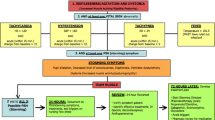Abstract
Background
Paroxysmal sympathetic hyperactivity (PSH) is a complication of acquired brain injury manifesting with episodic tachycardia, tachypnea, hypertension, diaphoresis, hypertonia, and posturing. No universally accepted diagnostic criteria exist and diagnosis is often delayed until the rehabilitation phase.
Methods
Electronic records were screened to identify consecutive cases of PSH diagnosed in an intensive care unit (ICU) between 1/2006 and 8/2012 and assess the validity of early clinical diagnosis against formal diagnostic criteria. Data collected included patient demographics, brain injury etiology, symptoms noted by the clinician to support the diagnosis of PSH, PSH manifestations, therapeutic interventions, relevant brain imaging, and investigations to exclude alternative diagnoses. An operational set of diagnostic criteria based on previous literature was used for comparison.
Results
Fifty-three consecutive patients with PSH were identified. Mean age was 33.6 ± 14.5 years (range 16–67). Traumatic brain injury was the most common etiology (30 patients, 56.6 %) but causes were diverse. Mean time to diagnosis was 8.3 ± 11.0 days; 31 patients (59 %) were diagnosed within 7 days and 20 patients (38 %) within 3 days of admission. Tachycardia was almost uniformly present, and diaphoresis, fever, hypertension, and tachypnea were also present in most cases. Dystonia and posturing were present in less than half of patients. 89 % of clinically diagnosed cases met formal diagnostic criteria.
Conclusions
Paroxysmal sympathetic hyperactivity can be diagnosed early in the ICU. Strict diagnostic criteria supported the clinician’s diagnosis in the majority of cases. Diagnosis should not be rejected because of any particular sign’s absence, especially dystonia and posturing.
Similar content being viewed by others
References
Perkes I, Baguley IJ, Nott MT, Menon DK. A review of paroxysmal sympathetic hyperactivity after acquired brain injury. Ann Neurol. 2010;68:126–35.
Rabinstein AA. Paroxysmal sympathetic hyperactivity in the neurological intensive care unit. Neurol Res. 2007;29:680–2.
Baguley IJ, Nicholls JL, Felmingham KL, Crooks J, Gurka JA, Wade LD. Dysautonomia after traumatic brain injury: a forgotten syndrome? J Neurol Neurosurg Psychiatr. 1999;67:39–43.
Fernandez-Ortega JF, Prieto-Palomino MA, Garcia-Caballero M, Galeas-Lopez JL, Quesada-Garcia G, Baguley IJ. Paroxysmal sympathetic hyperactivity after traumatic brain injury: clinical and prognostic implications. J Neurotrauma. 2012;29:1364–70.
Dolce G, Quintieri M, Leto E, et al. Dysautonomia and clinical outcome in vegetative state. J Neurotrauma. 2011;25:1079–82.
Perkes IE, Menon DK, Nott MT, Baguley IJ. Paroxysmal sympathetic hyperactivity after acquired brain injury: a review of diagnostic criteria. Brain Inj. 2011;25:925–32.
Rabinstein AA, Benarroch EE. Treatment of paroxysmal sympathetic hyperactivity. Curr Treat Options Neurol. 2008;10:151–7.
Heffernan DS, Inaba K, Arbabi S, Cotton BA. Sympathetic hyperactivity after traumatic brain injury and the role of beta-blocker therapy. J Trauma. 2010;69:1602–9.
Baguley IJ, Heriseanu RE, Gurka JA, Nordenbo A, Cameron ID. Gabapentin in the management of dysautonomia following severe traumatic brain injury: a case series. J Neurol Neurosurg Psychiatr. 2006;78:539–41.
Krach LE, Kriel RL, Morris WF, Warhol BL. Central autonomic dysfunction following acquired brain injury in children. Neurorehabil Neural Repair. 1997;11:41–5.
Fearnside MR, Cook RJ, McDougall P, McNeil RJ. The Westmead Head Injury Project outcome in severe head injury. A comparative analysis of pre-hospital, clinical and CT variables. Br J Neurosurg. 1993;7:267–79.
Moussouttas M, Lai EW, Khoury J, Huynh TT, Dombrowski K, Pacak K. Determinants of central sympathetic activation in spontaneous primary subarachnoid hemorrhage. Neurocrit Care. 2012;16:381–8.
Rabinstein AA. Paroxysmal autonomic instability after brain injury. Arch Neurol. 2004;61:1625.
Baguley IJ. The excitatory:inhibitory ratio model (EIR model): an integrative explanation of acute autonomic overactivity syndromes. Med Hypotheses. 2008;70:26–35.
Conflict of interest
Joshua D. Hughes and Alejandro A. Rabinstein have no conflicts of interest to declare.
Author information
Authors and Affiliations
Corresponding author
Rights and permissions
About this article
Cite this article
Hughes, J.D., Rabinstein, A.A. Early Diagnosis of Paroxysmal Sympathetic Hyperactivity in the ICU. Neurocrit Care 20, 454–459 (2014). https://doi.org/10.1007/s12028-013-9877-3
Published:
Issue Date:
DOI: https://doi.org/10.1007/s12028-013-9877-3




